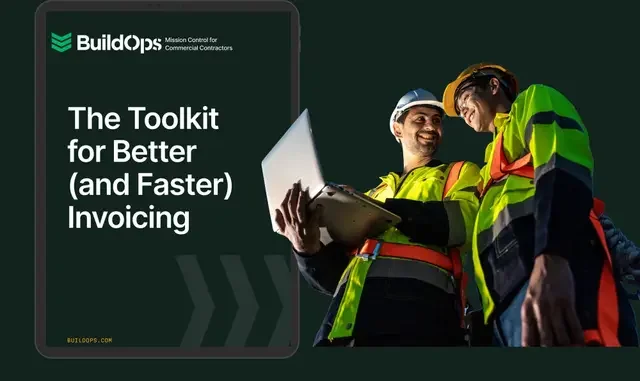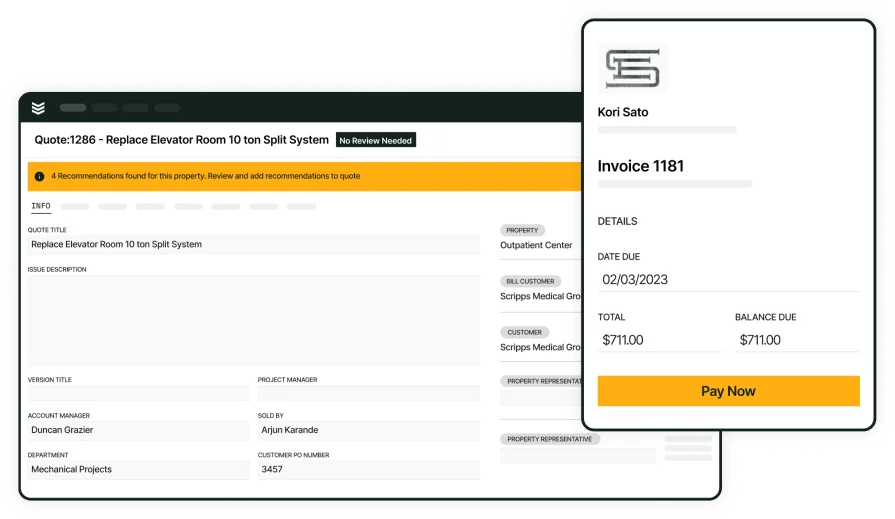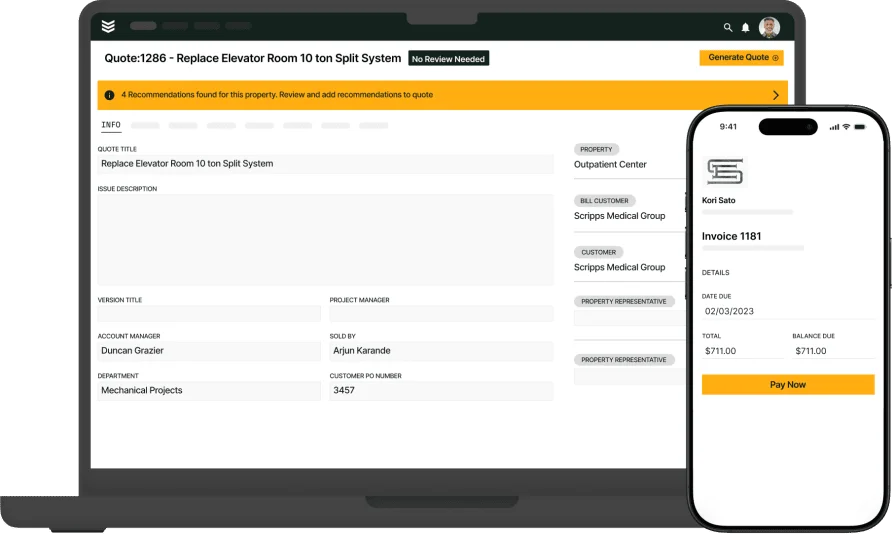Two key parts of mastering field service management are invoicing and pricing. After all, you can’t keep your field service company going if you don’t get paid. One thing that will help you get cash in the bank faster is to send your invoices out as soon as possible after jobs are complete.
The other thing that motivates customers to pay on time is knowing exactly what they’re paying for. Having fair, accurate, and honest field service pricing makes customers more inclined to pay within a reasonable time frame. So how do you achieve that? It can be tricky because every field service trade is a bit different, and there are a variety of pricing models out there that work better for some kinds of jobs than others.
Let this article be your guide as we cover:
- 7 common field service pricing models businesses use
- What goes into an estimate when pricing field services?
- 6 steps for how to price field services for your business
- Examples of field service management pricing for different industries
- 5 tips for how to achieve fair and competitive field service pricing
We’ll start by outlining some common methods field service businesses use to structure their pricing, and some types of costs they typically need to consider when setting their rates.
Expert Tip
According to our research, the Invoicing Sweet Spot is within 10 days of finishing a job. Take any longer than that to send it, and you could be waiting anywhere from 5 to 30 more days to get paid.
7 common field service pricing models businesses use
When it comes to pricing models for field services, there are a bunch of different ones you can pick from. Some may work better than others depending on your industry, your customer base, the types of jobs you do most often, and so on. Here are 7 systems that you’ll commonly see used in field service:
- Flat Rate Pricing – Each service, job, or project is given a fixed price. The customer pays the same amount for the services they need regardless of how long a project takes or what materials it requires.
- Cost-Plus – The customer pays the total cost of completing the job plus a markup so you can make a profit.
- Hourly – Techs are given hourly work rates, so the final price depends on how long the work takes to get done.
- Time and Materials (T&M) – The customer’s final price is based on how long the job takes to complete and the cost of purchasing the materials needed to complete the job.
- Tiered Service Levels – Also known as the “Good, Better, Best” model, it offers different prices for corresponding levels of service. This gives customers flexibility instead of having to make an all-or-nothing choice.
- Subscription-Based – Customers pay a recurring fee (usually monthly or annually) for continuing service. This pricing model is common with maintenance contracts.
- Value-Based – You price your services according to how much you think the customer values them. This requires knowing a lot about your customers’ wants and opinions, your service’s market conditions, what your competitors are doing, and your own company’s value propositions.
If you own a small shop and are having trouble deciding on a model, consider using field service software for small businesses to run some tests and see which system works out best.
What goes into an estimate when pricing field services?
One of the most common mistakes field service companies make when estimating or quoting is not factoring in all potential costs involved. This leads to not charging customers enough to cover your costs, which impacts your ability to be profitable.
Here are 8 types of costs you need to consider when setting prices for your field services:
- Time / Labor – Costs related to the technical skills required to do a job and how long a job takes to finish.
- Parts, Units, and Materials – The cost of items you’re going to install, or use to repair or replace something, at the work site.
- Travel – The time, vehicle, and fuel costs of getting your techs between work sites. Note that vehicle costs can also include things like maintenance, repairs, insurance, and licensing.
- Equipment Usage – Costs related to using, powering, and maintaining your work equipment.
- Emergency Response – An extra cost or higher hourly rate if a customer needs your services immediately, giving you little time to prepare for the job.
- Unexpected Project Costs – Costs caused by unexpected delays such as traffic, road closures, bad weather, jobs being more complicated than you first thought, or additional issues that need to be addressed on a job.
- Overhead – Operational costs not directly related to doing field work such as property leasing, utilities, office supplies, advertising, insurance, administrative employee salaries, and field service manager software.
- Taxes – Costs you have to pay to the government on materials, equipment, fuel, sales, etc.

Download the invoicing guide
Don’t just price jobs right, make sure you invoice—and get paid—quickly.
6 steps for how to price field services for your business
You know you have to account for your business’s expenses in fulfilling field service calls, and you should pick a pricing system that makes sense for both your business and its customers. But what else goes into pricing field services? To answer that question, we’ll give you a six-step cycle you can use in your field service management for pricing your services.
1. Consider all the costs you have to cover for
To know how much money your business needs to take in to be successful, you first need to know how much is coming out of it. That includes totaling up each of the types of costs covered in the section above. Once you know what your cash outflow is, you can start planning your pricing around what you need to earn to be profitable.
2. Research current market conditions
Of course, you can’t just charge whatever you want to make as much profit as you can. Factors like what’s going on in your industry, local demand, what your competitors are doing, and the overall state of the field service market will affect how much customers are willing to pay for your services. Do some research to find some current prices or ranges you can use as starting points.
3. Choose pricing models and set your rates
Based on your research, decide on the methods you’ll use to price your services. Also use these considerations to set your rates competitively. Using a pricing strategy like this makes your estimates and invoices more accurate and faster to put together. It also makes pricing simpler for your customers to understand, which they will appreciate.
4. Factor in the details of a specific job in forming an estimate or quote
When a customer makes a request, gather as much information about their project as you can, including making a visit to the work sites if necessary. What services do they need? What parts and equipment are required? How far away are they? Do they need services at more than one location? How long will the work likely take, and is it likely you’ll have to come back for more than one visit to a work site to finish it?
This information will help you make a more accurate estimate or quote. Again, if you already have pricing models in place, this will be faster and simpler to do too.
5. Send out an invoice and collect payment after the job's done
Once the work is done, send out an invoice based on the actual cost of the project according to your rates. It may end up being different from your initial estimate if you encountered unexpected issues during the job or needed special parts or equipment to finish the job. In any case, itemize all charges on the invoice so it’s clear to the customer what they’re paying for.
Remember to send out an invoice as soon as you can after the project is complete, or else it tends to take extra time for the customer to actually pay it. Having pre-set pricing strategies will help with this, as it will make calculating the final prices easier and faster. Even better is if you can use invoice automation software to generate invoices and take payments right at a job site, which means you don’t have to go chasing customers for payments with follow-up emails.

Invoice automation for field service
See how BuildOps can automate quoting to invoice to payment, all in one tool.
6. Use invoices and field reports to inform your prices
After a job is over, your invoices and field service reports for that job become valuable tools for setting your prices in the future. First, you can check the parts and equipment used, as noted in your field reports, against the items in your invoices to make sure they match up and that you haven’t charged too little or too much.
Second, you can note the amount of resources (time, materials, fuel, etc.) used for the job and what price you charged for it. Then you can use those metrics as references to more accurately price similar projects in the future.
Third, you can analyze customer feedback from the field (and elsewhere). It may contain hints on whether your prices are too high or too low, or what you could be doing to provide better service value for your customers’ money (e.g. faster work, better customer service, or less disruption).
An automated and all-in-one tool like BuildOps’ invoicing-integrated field service software will give you a field service report template structured so that you can use AI to translate it into an invoice with the push of a button! It also does many other things that make managing and doing your field service work more efficient so you can lower your costs instead of raising your prices to compensate.
Examples of field service management pricing for different industries
Based on your specific trade, you may need to adjust your field service business model a bit to account for certain quirks in your industry. The points below will offer some industry-based pricing of services examples.
1. HVAC
Average residential repair: $150-$450
Average residential maintenance: $75-$200 ($500 for annual service contract)
Average commercial repair: $450-$1000 (not including parts)
Average commercial maintenance: $1700/year ($500-$2000 per unit)
One of the main things that uniquely affects HVAC industry service pricing is right there in the acronym: it covers heating, ventilation, and air conditioning, which means costs can differ significantly depending on what type of system needs to be serviced. For example, the average residential air conditioning repair is about $320, while the average heating repair is about $270.
Prices can also depend on use case and system size. Typically, commercial HVAC systems are larger than residential ones, so they cost more to maintain or repair. The extent of work needed (minor vs. major repairs) and local market conditions affect field service pricing too.
To learn more or help you with creating your own HVAC invoicing system, check out our collection of the best HVAC invoice templates, as well as our guide with standout HVAC invoice examples.
2. Electricians and electrical contractors
Average residential job: $350-$535
Average commercial job: $7-$15 per square foot
Average commercial electrician rate: $100-$150 per hour
Average large project cost: $2000-$10,000
Depending on the use case and the contractor, electrical service industry pricing is calculated very differently. A residential job may charge a flat rate, while a larger commercial job may charge based on the square footage of the space – both along with hourly tech rates. Electricians of different skill levels may also charge varying rates.
But typically the biggest factor in pricing electrical work is the scope of the work. Some electrical services are small, simple jobs like replacing circuit breakers, repairing outlets, and installing switches or fixtures. These usually aren’t priced at more than a few hundred dollars. Other electrical contractors have to tackle larger or more complicated projects, like installing backup generators, upgrading electrical panels, or rewiring an entire building. They can potentially charge several thousand dollars for these jobs.
For some starting points, see our lists of electrical contractor invoice templates and electrician invoice templates. You can also get some inspiration from our list of top 10 electrical invoice examples.
3. Plumbing
Average residential small repairs: $125-$350
Average residential medium/large job: $500-$800
Average commercial rough-in plumbing cost: $4-$6 per square foot
Average plumber rate: $100 per hour
Like with electrical work, pricing services in the plumbing industry can vary greatly depending on the relative size or difficulty of a project. Simpler jobs like installing a faucet or toilet, and fixing clogged or leaky fixtures, generally only cost a few hundred dollars. Larger or more complicated plumbing jobs, such as repairing a pipe leak, cleaning drains, or servicing water heaters can cost several hundred to thousands of dollars.
Another variable is the plumber’s skill level (apprentice, journeyman, or master) and whether they specialize in residential, commercial, or industrial jobs. The type of job can also affect how it’s priced (i.e. fixed rates vs. per-square-foot rates). Plumber rates can also increase for appointments that are emergencies or scheduled for non-standard hours (such as weekends and holidays), costing an average of $125-$300 per hour.
Look over our list of top plumbing invoice templates for some ideas on where to start.
4. Refrigeration
Average repair: $150-$1250
Average commercial installation: $5000-$20,000
Average medical installation: $17,000-$25,000
A few things complicate pricing in the refrigeration field service industry. One is the refrigerant chemicals themselves, which often must meet strict regulations and require specific equipment to handle. Another is the use case. Refrigeration for residential use, or commercial use like in supermarkets and restaurants, usually doesn’t need as many specialized parts, though the jobs may be larger in scope. In contrast, refrigeration for science and medicine needs to be much more exact because it’s typically used to store chemicals and biological samples that are highly sensitive to temperature changes. So these jobs may be smaller but require more custom equipment and greater expertise.
See our list of top refrigeration invoice templates to learn more about what we mean.
5 tips for how to achieve fair and competitive field service pricing
Here, we’ll go a bit more into detail about how to come up with your field service pricing strategies.
1. Account for all associated costs
If you’re not bringing in more money from completed field service jobs than you’re spending to get them done, you aren’t being profitable. That may sound obvious, but many field service companies end up undercutting their profits because they haven’t factored all costs into field service pricing. Sure, you need to pay your techs, buy and maintain their equipment, and buy any materials you need for a job. But you also need to think about less obvious costs like:
- Buying/leasing/renting vehicles and paying for fuel to get techs quickly between work sites
- Jobs that need more materials and more of your techs’ time because they’re more complicated than you first thought
- Overhead costs like building rent, utilities, office supplies, and insurance
- Paying employees not directly involved in field work (admin, accounting, legal, marketing, sales, etc.)
- The price of any field service software you use for your operations
- Tax on most or all of the above
You need to find and add up all instances of money coming out of your business to know how many jobs you need to complete – and what you need to charge for them – to turn a profit.
2. Don’t price too low or too high
If your prices are too low, you won’t profit. If your prices are too high, you risk losing customers to less expensive competitors. It’s a tightrope you have to walk that’s easy to talk about in theory, but much harder to deal with in practice. There are a few strategies you can use to succeed in this:
- Use a tiered “Good, Better, Best” pricing model – Your customers can pay a lower price if they just need the essential services, or spend a little more if they want extra work done.
- Use penetration pricing – You initially set prices low and take losses in a certain market to build a customer base. Then, as demand grows, you gradually raise your prices accordingly until you start profiting.
- Use price skimming – You introduce a unique service your competitors aren’t offering and set the price high to start. Then, if your competitors start offering the service too, drop the price to be more competitive.
3. Look at how your competitors are pricing their services
Speaking of competitors, they can be great assets in deciding what to charge for your services. After all, if you want your prices to be competitive, you have to watch what your competitors are doing.
Look at what services they’re offering, what rates they’re charging, and what pricing models they’re using. That will give you clues regarding how to set your rates and what to set them at – especially if you’re offering a service that your competitors aren’t.
You may also get hints on how you could use promotions and other sales tactics to draw in customers. For example, you may use “bundles” where you offer discounts to customers who ask for more than one type of service in a single service request.
4. Automate your data collection and price calculations
Use field management software instead of doing cost calculations by hand. It gathers all your operating costs, so you know what prices you need to make money. Then, you can try out different pricing plans in the software to see how much you could earn under different situations. This helps you find the best field service pricing model without the risks of guessing in the real world.
You can also use something like small business scheduling and invoice software to itemize the charges for a job and then calculate a total, which makes creating invoices much faster and easier. And If your expenses change, you can simply adjust them in the software and it will re-calculate your cash outflow for you. All of this is faster than doing these calculations manually, and it also lowers the risk of you making a mistake that throws the rest of your math off.
5. Review prices regularly to match market conditions
Remember that you aren’t setting your prices in a vacuum. Your competitors may adapt or respond to what you do, suppliers may start having sourcing issues, overall economic conditions could lead to sudden shifts in industry demand, and so on. So it’s important to frequently compare your prices to your expenses, your competitors’ prices, the overall market demand for your services, etc. and adjust them if necessary.
No matter which pricing strategy you use for your field service business, it’s still critical to get paid in a timely manner. BuildOps’ invoicing software can help. It automatically syncs to your work orders so you don’t miss any details, and allows you to preset pricing and markups to make calculating the final bill much faster. It also features one-click invoice approval to reduce delays in sending out invoices, and can track the statuses of invoices (i.e. sent, paid, or overdue) in real time. Finally, it offers flexible payment options so customers can pay invoices faster without needing to jump through hoops.

See BuildOps in action
We help contractors streamline operations for better estimating and billing.







